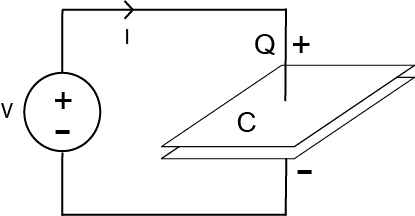This calculates the capacitance of a capacitor based on its charge, Q, and its voltage, V, according to the formula, C=Q/V.
Output
Overview
Our capacitance calculator will help you evaluate the capacitance of a capacitor if the charge Q (in coulombs) and voltage V (volts) is given.

Calculating Capacitance
$$C = \frac{Q}{V}$$
Where:
$$C$$ = capacitance in farads (F)
$$Q$$ = charge in coulombs (C)
$$V$$ = voltage in volts (V)
Capacitance is a property characterized by a capacitor - an electrical component that can hold charge. The formula above tells us that a higher capacitance value means a higher value of stored charge. A capacitor, being one of the three basic circuit components along with the resistor and the inductor, is found in many applications. It's usually used as an energy storage device as well as a key component in filters and oscillators.
Notes
- Capacitance can also be exhibited by other materials besides capacitors. The basic requirement to be able to store energy in an electrostatic field (capacitance) is to have an insulator (dielectric) sandwiched between two plates.
- Capacitance can also be computed using a material's intrinsic properties. For example, the formula for a parallel-plate capacitor given the cross-sectional area of its plates and the distance between them is:
$$C = \epsilon_{r} \frac{A}{d}$$
- The energy stored in a capacitor is both a function of its capacitance and the voltage across it. This why larger-sized capacitors (which have larger capacitor values) hold more energy than smaller ones.
Further Reading
Textbook - Electric Fields and Capacitance






1 CommentLogin
HOW CAN I GET Q?